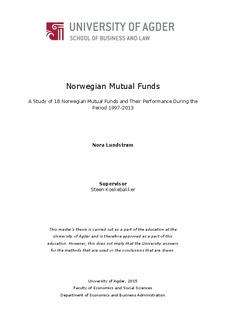| dc.description.abstract | In this study I have analysed 18 Norwegian mutual equity funds during the period 1997-2013.
All of the mutual funds are registered at the Oslo Stock Exchange as of December 2013. The
purpose of the study was to analyse the performance of these funds, and find whether or not
the funds were able to outperform their benchmark, both for the whole period and for shorter
periods during the 17-year sample period. By dividing the whole period into shorter periods I
have evaluated the mutual funds during periods of bull and bear markets. I wanted to see if
there exists a connection between different stock market cycles and mutual funds excess
return.
Using linear regression and calculation of three well-known performance measures, the
Sharpe ratio, the M2 measure and the information ratio, I have evaluated the mutual funds
performance through the research period. Both the linear regression and the performance
measures evaluate the mutual funds against a benchmark index, and in my research I have
data from the Oslo Stock Exchange Mutual Fund Index (OSEFX).
Based on the regression analysis and the performance measures I have ranked the mutual
funds. When not taking any risk measures into account, an equally-weighted portfolio of all
my mutual funds had lower total return than OSEFX. However, individually 50% of the funds
showed higher total return than OSEFX. When adjusting for risk, using performance
measures, there were both mutual funds outperforming and underperforming OSEFX.
However, in the calculations of both risk-adjusted and clean return-based measurements the
highest ranked mutual funds based on one measure seemed to repeat and rank high in other
measurements as well. When analysing the shorter periods, the results were not as consistent.
Outperforming OSEFX in periods of upswing did not necessarily imply outperformance of
OSEFX in periods of recession and vice versa.
From the regression analysis I cannot conclude that the funds have significant alpha values,
and therefore no significant risk-adjusted excess return. However, based on the performance
measures and excess return some of the funds did beat their benchmark. | nb_NO |
